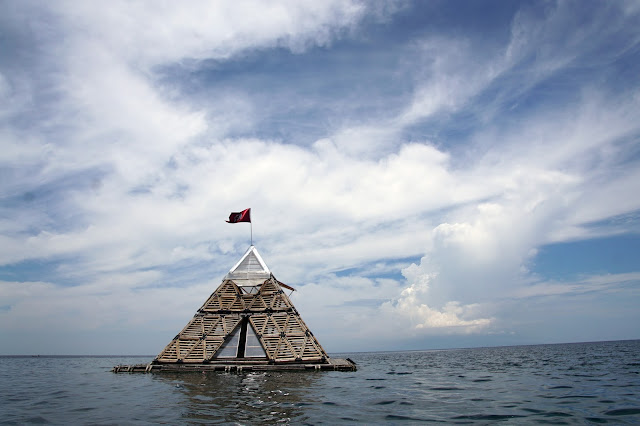 |
| Estudio Damgo IV students visit Estudio Damgo I, Dungga Classroom, located in the rural mountain village of Maluanay Valencia. |
 |
| Dungga Classroom |
 |
| Estudio Damgo IV student, walks on a new concrete path which was added to the school grounds within the past year. |
 |
| An outdoor kitchen has been built next to Dungga Classroom. |
 | ||||
| DSWD's tarpaulin sign for the feeding program at Dungga Daycare. |
At Estudio Damgo's second project we took surveys from 7 Core Shelter community members. The surveys reveal that the residents are satisfied with the multipurpose hall design and performance of the structure after one year of use. During the survey discussions, the president of Core Shelter, Jona David, expressed her gratitude for the building. She reflected that before the multipurpose hall was built, residents would meet in one of the houses to hold community meetings. There are over 50 households in the community. The homes are small, one-room spaces that hold no more than 10 people comfortably. Before, not all residents felt welcomed to join the discussions. If they did attend meetings, residents would stand in the street or outside the window to participate. Now, community meetings are filled with 50-60 residents at each meeting. The multipurpose hall can accommodate at least one representative from each household to participate in under one roof. The president emphasized, by having a neutral space, it has largely benefited the community to resolve conflicts. Before, conflicts between two families would be addressed in a third-party home. Now, the multipurpose hall creates a neutral and safe space to have meaningful discussions, creating harmony among the community. It was also expressed that the residents prefer to use the multipurpose hall to resolve issues rather than going to the barangay hall.
 |
| Estudio Damgo II, Multipurpose Hall for the flood survivors at Core Shelter. Residents are growing vegetable starts in pots along the exterior of the building. |
 |
| Using the multipurpose hall, Ma'am Gerldine Quinones, discusses the survey with the president of Core Shelter, Jona David. |
 |
| Estudio Damgo alumni assist the research and building assessment. |
Estudio Damgo's third project was just launched and turned over to the beneficiaries on July 6, 2015. The two month old floating pyramid is a marine sanctuary center for the fish wardens near Silliman Beach in Barangay Bantayan, Dumaguete. After surveying 7 residents living along the shore, we learned that the community and the fish wardens are generally happy about the new floating structure. They believe it is a great addition to keep surveillance and monitor illegal fishing in the area; however, they expressed concerns about the upcoming typhoon season this November. They think the strong winds will cause high waves and damage the structure. Time will reveal how well the structure can handle the environment.
Regardless of any concerns, the residents have discovered larger fish in the area since the launch of the floating structure. The pyramid is creating a protected habitat beneath the structure, which provides shade and the growth of sea grass. This is a good sign that the structure is contributing to the local fish population in size and numbers, as well as staving off illegal fishing boats. In addition to being a structure that watches over the area, the Marine Sanctuary Center is designed for tourists and public access. Unfortunately, the barangay council members have posted a very clear sign stating, "Notification Prohibited. Anyone caught using the marine guard house will be arrested and fined." Geraldine and I will be attending the next barangay council meeting to discuss the intended use of the sanctuary and hopefully make an agreement between the community and the barangay for its intended use as a public structure.
 |
| Estudio Damgo III, the Marine Sanctuary Center. |
 |
| Exterior view of the Marine Sanctuary Center. |
 |
| Interior view of the Marine Sanctuary Center. |
 |
| The clearly posted sign stating, "Anyone caught using the marine guard house will be arrested and fined." |
 |
| Estudio Damgo alumnus surveys the residents. |
The positive reactions expressed by the community from all three projects, are fuel for Foundation University's Estudio Damgo program to continue creating meaningful structures that enable positive change within the community. Overall, we're learning that each building has been well received by community residents and beneficiaries. The qualitative research and post-occupancy evaluations will contribute to the program's success and longevity.
No comments:
Post a Comment